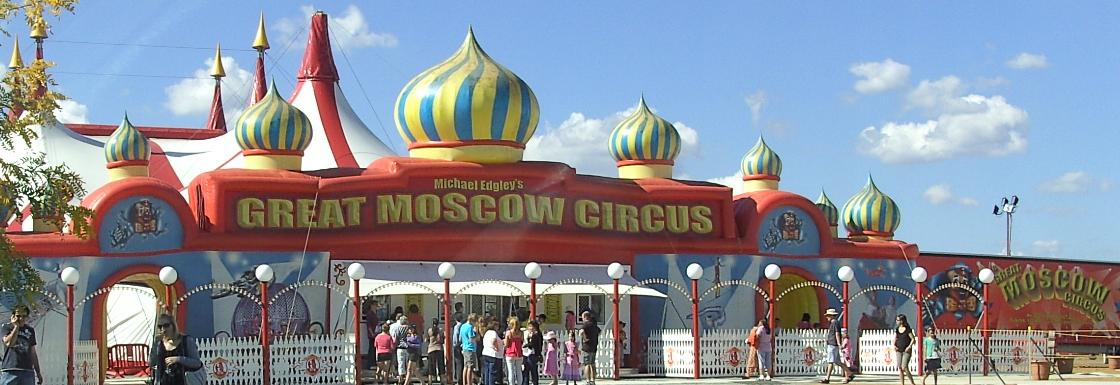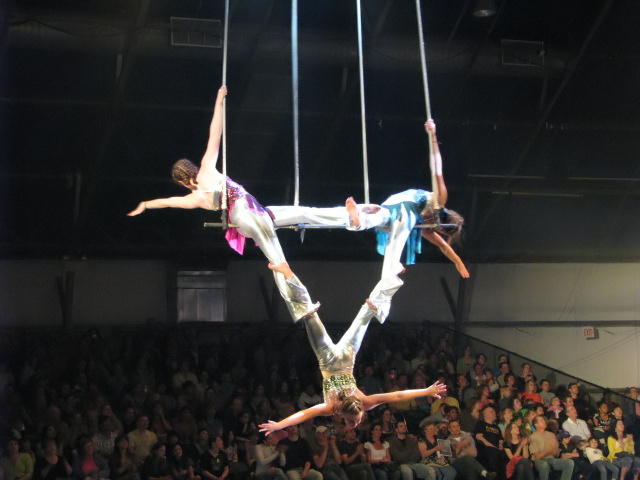|
Cradle (circus Act)
The cradle (also known as aerial cradle or casting cradle) is a type of aerial circus act in which a performer hangs by his or her knees from a large rectangular frame and swings, tosses, and catches another performer. The aerialist being swung is referred to as a flyer, while the one doing the tossing and catching is referred to as a catcher or caster. The flyer usually starts and ends standing on the frame above the catcher. The flyer swings holding on to the catcher's hands, performs releases at the top of the swing, and is re-caught in mid-air. The frame can be static or swinging. A variant called the Russian cradle or Korean cradle has the catcher/caster standing, secured by a safety belt. This type of aerial performance has been used in many circuses, both in "big tops" and on stage, including by Cirque du Soleil and the Moscow State Circus The title Moscow State Circus is used for a variety of circuses. Most commonly, it refers to one of the two circus buildings in ... [...More Info...] [...Related Items...] OR: [Wikipedia] [Google] [Baidu] |
Cadre Aerien
Cadre may refer to: *Cadre (military), a group of officers or NCOs around whom a unit is formed, or a training staff *Cadre (politics), a politically controlled appointment to an institution in order to circumvent the state and bring control to the party *Cadre (company), a New York-based real estate financial technology firm *Adam Cadre, an American writer *CADRE Laboratory for New Media at San Jose State University *Constructor Acquires Destructor Releases, alternate name for Resource Acquisition Is Initialization programming idiom {{disambiguation, surname ... [...More Info...] [...Related Items...] OR: [Wikipedia] [Google] [Baidu] |
Circus
A circus is a company of performers who put on diverse entertainment shows that may include clowns, acrobats, trained animals, trapeze acts, musicians, dancers, hoopers, tightrope walkers, jugglers, magicians, ventriloquists, and unicyclists as well as other object manipulation and stunt-oriented artists. The term ''circus'' also describes the performance which has followed various formats through its 250-year modern history. Although not the inventor of the medium, Philip Astley is credited as the father of the modern circus. In 1768, Astley, a skilled equestrian, began performing exhibitions of trick horse riding in an open field called Ha'Penny Hatch on the south side of the Thames River, England. In 1770, he hired acrobats, tightrope walkers, jugglers and a clown to fill in the pauses between the equestrian demonstrations and thus chanced on the format which was later named a "circus". Performances developed significantly over the next fifty years, with large-scale theat ... [...More Info...] [...Related Items...] OR: [Wikipedia] [Google] [Baidu] |
Aerialist
Acrobatics () is the performance of human feats of balance, agility, and motor coordination. Acrobatic skills are used in performing arts, sporting events, and martial arts. Extensive use of acrobatic skills are most often performed in acro dance, circus, and gymnastics, and to a lesser extent in other athletic activities including ballet, slacklining and diving. Although acrobatics is most commonly associated with human body performance, the term is used to describe other types of performance, such as aerobatics. History Acrobatic traditions are found in many cultures, and there is evidence that the earliest such traditions occurred thousands of years ago. For example, Minoan art from c. 2000 BC contains depictions of acrobatic feats on the backs of bulls. Ancient Greeks practiced acrobatics, and the noble court displays of the European Middle Ages would often include acrobatic performances that included juggling. In China, acrobatics have been a part of the culture sin ... [...More Info...] [...Related Items...] OR: [Wikipedia] [Google] [Baidu] |
Russian Cradle
Russian(s) refers to anything related to Russia, including: *Russians (, ''russkiye''), an ethnic group of the East Slavic peoples, primarily living in Russia and neighboring countries *Rossiyane (), Russian language term for all citizens and people of Russia, regardless of ethnicity *Russophone, Russian-speaking person (, ''russkogovoryashchy'', ''russkoyazychny'') *Russian language, the most widely spoken of the Slavic languages *Russian alphabet *Russian cuisine *Russian culture *Russian studies Russian may also refer to: *Russian dressing *''The Russians'', a book by Hedrick Smith *Russian (comics), fictional Marvel Comics supervillain from ''The Punisher'' series *Russian (solitaire), a card game * "Russians" (song), from the album ''The Dream of the Blue Turtles'' by Sting *"Russian", from the album ''Tubular Bells 2003'' by Mike Oldfield *"Russian", from the album '' '' by Caravan Palace *Nik Russian, the perpetrator of a con committed in 2002 *The South African name for a ... [...More Info...] [...Related Items...] OR: [Wikipedia] [Google] [Baidu] |
Cirque Du Soleil
Cirque du Soleil (, ; "Circus of the Sun" or "Sun Circus") is a Canadian entertainment company and the largest contemporary circus producer in the world. Located in the inner-city area of Saint-Michel, it was founded in Baie-Saint-Paul on 16 June 1984 by former street performers Guy Laliberté and Gilles Ste-Croix. Originating as a performing troupe called ''Les Échassiers'' (; "The Stilt Walkers"), they toured Quebec in various forms between 1979 and 1983. Their initial financial hardship was relieved in 1983 by a government grant from the Canada Council for the Arts to perform as part of the 450th anniversary celebrations of Jacques Cartier's voyage to Canada. Their first official production ''Le Grand Tour du Cirque du Soleil'' was a success in 1984, and after securing a second year of funding, Laliberté hired Guy Caron from the National Circus School to recreate it as a "proper circus". Its theatrical, character-driven approach and the absence of performing animals help ... [...More Info...] [...Related Items...] OR: [Wikipedia] [Google] [Baidu] |
Moscow State Circus
The title Moscow State Circus is used for a variety of circuses. Most commonly, it refers to one of the two circus buildings in Moscow, the " Circus Nikulin" (the old circus, featuring animal acts) and the "Bolshoi Circus" (the new circus, featuring trapeze and acrobatics), or to traveling shows which may or may not be directly related to Russia.Circopedia: The Free Encyclopedia of the International Circus, s.v. "Moscow Circus.(Accessed May 3, 2011) The Russian Circus rose during the Soviet Union, Soviet period, when acts from many Russian circuses united to tour the United States under the title, "The Moscow Circus."Glenn Collins. "The Moscow Circus: Vaudeville That Delivers a Nationalistic Message," The New York Times. September 11, 1988. During this time, the circus became a point of pride. Russian Circus traditions include clowning, juggling, acrobatics, contortion, and animal acts (especially bear acts, such as bears who juggle with their feet).Miriam Birch. Inside the ... [...More Info...] [...Related Items...] OR: [Wikipedia] [Google] [Baidu] |
Static Trapeze
Static trapeze, also known as fixed trapeze, is a type of circus art performed on the trapeze. In contrast to the other forms of trapeze, on static trapeze the bars and ropes mainly stay in place. Most often, the static trapeze is about wide and the bar is generally inches in diameter. The ropes are at least two human lengths, as many figures are performed on the ropes above the bar. The ropes can be made of many materials, including cotton or hemp, and often have a wire woven inside. It can be performed by a single artist or two partners working together. A single artist will do tricks above and below the bar, the ropes playing just as important a part as the bar. A partner act will involve the partners working together — supporting each other's weight, throwing, lifting and catching each other. Self-standing trapezes can be purchased for home use. Multiple trapeze is an act entailing the use of more than one trapeze, typically two or three. In these acts, multiple people ... [...More Info...] [...Related Items...] OR: [Wikipedia] [Google] [Baidu] |




